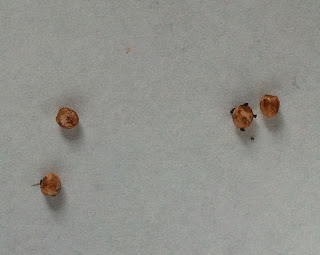 |
| Cecropia pupa |
On October 26th we removed the cocoons from the refrigerator after exactly five months of winter simulation. The outer cocoons were very brittle, paper-like, and dry (you may recall they are made from leaves bound with silk). We read that it is OK to remove the outer and inner cocoons to get a look at the pupa, and naturally we were curious. After some research about the proper way to do this we got to work.
 |
| One of the cocoons (outer) |
Using a pair of fly-tying scissors, we trimmed back the outer cocoon. This part is relatively easy since the skin of the outer cocoon is so dry and brittle. It is important to keep the scissors as close to the surface of the cocoon as possible. If the pupa is punctured it could result in death.
 |
| Here and below: The outer cocoon and inner cocoon |
 Next, the scissors were taken to the inner cocoon, which is covered in a layer of silk that feels like thin, dry hair. The cocoon itself is brittle but thicker than the outer cocoon. Cutting through the inner cocoon feels much like cutting a thick piece of construction paper. Again, it is crucial that this is done slowly and with great care. The scissors should stay close to the surface of the cocoon so as to not puncture the pupa.
Next, the scissors were taken to the inner cocoon, which is covered in a layer of silk that feels like thin, dry hair. The cocoon itself is brittle but thicker than the outer cocoon. Cutting through the inner cocoon feels much like cutting a thick piece of construction paper. Again, it is crucial that this is done slowly and with great care. The scissors should stay close to the surface of the cocoon so as to not puncture the pupa.
We felt movement almost immediately after beginning to cut the inner cocoon. The pupa shook and vibrated inside. Pretty wild. We proceeded slowly. Eventually we created a big enough opening to see inside, and there he was, writhing and wriggling.
This particular pupa is a male, which we determined after seeing the large antennae.
 |
| Pupa, antennae view |
 |
| Pupa, rear view |
Below is a video of the pupa in motion.
After our success cutting open the first cocoon we decided to remove the outer cocoons from the three others so that everyone is on the same page. By doing this we also hoped to determine if the others are alive - and they are! After some harmless poking we felt movement from each inner cocoon.
We placed the four cocoons back in the aquarium where they started as wee black caterpillars. The aquarium is lined with brown paper and sticks are taped to the sides. When the moths emerge, they will climb up the sticks and hang vertically. We expect this will happen in the next week or two, so stay tuned.













.JPG)








.JPG)
.JPG)





















